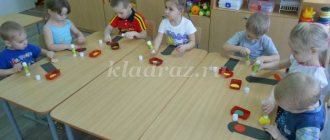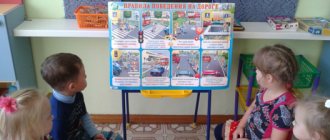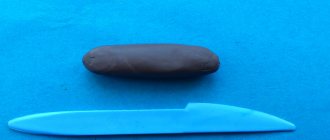Summary of OOD on traffic rules for children 2 - 3 years old “Pedestrian crossing”
Summary of organized educational activities with children of the first junior group (2 – 3 years old)
within the educational field “Cognitive Development”
on the topic "Pedestrian crossing".
Goal: familiarize children with the rules for safely crossing the road at a pedestrian crossing.
Tasks:
Educational: to form children’s ideas about correct behavior on the road; consolidate knowledge about types of transport, machine parts; learn to draw straight horizontal lines.
Developmental: develop interest in learning traffic rules, speech activity and articulation of children.
Educators: cultivate a conscious attitude towards the rules of safe behavior on the road.
Equipment: “Masha” doll, road with a pedestrian crossing, “Pedestrian crossing” sign, toy cars, cut-out pictures “Transport”.
OOD progress.
Educator. Guys, the doll Masha came to visit us. Let's say hello to her. (The children greet the doll, the teacher notices that the doll is upset about something.) Masha, tell me what happened to you (the doll speaks to the teacher in the ear). Masha was very scared today when she saw cars on the road.
Doll.
I was walking across the road
And I got a little confused
When to stand, when to go
And where to cross the road
Educator. Guys, let's help Masha. Masha went for a walk alone and there was no one to tell her where to cross the road. Do you think small children can walk alone?
Educator. Right! Children should walk with adults: with mom, dad, grandparents.
Guys, let's take a walk along the path. (get up from the chairs)
Fizminutka
Top, top legs
We walked along the path
The legs walked, walked, walked
And they came to the road.
Educator. Guys, look at the road there are some white stripes. They look like a zebra. This is a pedestrian crossing. The crossing is also indicated by this sign (look at the pedestrian crossing sign).
Educator. When crossing the road you need to be very attentive and careful. Holding hands is a must. First look left, then right. You can cross the road only if there are no cars.
Educator. Guys, let's become pedestrians and try to cross the road.
Game "We are pedestrians"
Guys, let's join hands. Let's look left, then right. And if there are no cars, then we cross the road. The game can be repeated several times.
Educator. Now Masha remembers how to cross the road correctly.
Educator. Guys, let's see what cars are driving on the road.
What kind of car is this? (Car). Who is she transporting? (Of people).
Let's see what parts the machine consists of.
Educator. What kind of car is this? (Cargo). What parts does this machine consist of? What can be transported in the truck?
Educator. How do the cars sound? (W-w-w). Let's all hum together, first quietly, then loudly.
Now let's honk the horn. (Beep) Quiet and loud.
Educator . Look what happened to these cars. They broke down and all the parts got mixed up. Can you fix cars?
D/game “Assemble cars ” (cut-out pictures).
Educator. Now the cars are ready to go. Where do the cars go? (On the way to).
Educator. Let's draw a road for our cars.
Drawing roads for cars.
On the topic: methodological developments, presentations and notes
Program objectives: Educational: Stimulate speech and motor activity in class. To promote positive emotions in the process of mastering the basic technique of sculpting, perfection.
Types of children's activities: cognitive-research, play, artistic and aesthetic. Goals: teach children to draw a snowman using a poke (cotton swab); exercise children in drawing.
Integrated educational activities in the logic of the Federal State Educational Standard for Education in the 1st junior group. Thematic week “RUSSIA IS MY MOTHERLAND!”, theme of the day “RUSSIAN BIRCH”.
Summary of a drawing lesson in the first junior group.
This lesson will introduce children to the Dymkovo toy. Will allow you to show interest in products of decorative and applied arts, in artistic creativity.
Objectives: Continue to teach children to depict simple objects in their surroundings. Strengthen children’s ability to draw in unconventional ways (finger printing technique). Develop color perception.
Source
Summary of a lesson on traffic rules in the 1st junior group. Traffic light
Lesson on traffic rules in the first junior group
Author: Anna Vladimirovna Samsonova, teacher at MBDOU “Kindergarten No. 86”, Miass, Chelyabinsk region. Description of the material: I offer you a summary of direct educational activities for young children (2-3 years old) on the topic “Our assistant is a TRAFFIC LIGHT.” This material will be useful for teachers of younger groups. This summary is aimed at consolidating traffic rules, in particular at consolidating ideas about traffic lights. As well as developing safe behavior skills on the road.
Summary of educational activities in the first junior group “Our assistant is a traffic light”
Integration of educational areas: “Communication”, “Safety”, “Cognition”, “Socialization”. Goal: Continue to develop safe behavior skills. Objectives: Educational: to consolidate children’s ideas about traffic lights and their actions; Developmental: consolidate knowledge of primary colors (red, yellow, green), round shape; Educators: instill in children a desire to acquire new knowledge; safe behavior. Preliminary work: P/I “Find your color”, looking at illustrations, observing transport. Demonstration material: traffic light model, bear toy, circles of red, yellow, green colors.
Progress of GCD
Educator: guys, a bear came to visit us today, he came to us from his doll town, he is very interested in how our children play in kindergarten. Let's say hello to the bear in unison. Children say hello. The teacher takes the children to the traffic light and asks Guys, look here, what is this worth here? Children's answers. Educator: Why do we need it? Children's answers. Educator: He stands on the streets of the city and with his eyes shows people and cars when they can drive or cross the road. Guys, let's count together how many eyes he has? Children's answers. Educator: Leva, what kind of eye does the traffic light have at the bottom? Samir, what kind of eye does the traffic light have at the top? Masha, what kind of eye does the traffic light have in the middle? Educator: Now let's remember what we do if the light is red? Children's answers. Educator: What do we do if the light is yellow? Children's answers (hands have been prepared) Educator: And if the light turns green, then we can go, go. Children stomp their feet. Educator: Now let's go for a walk. Look how interesting the path is. What's on the path? Children: stripes. Educator: What color are they? Children: white, black. Educator: Look what I have in my hands? Children: zebra Teacher: This is such a horse. It has white and black stripes. This horse's name is zebra. Repeat, what is the horse's name? Children: zebra. Educator: Our track has the same stripes as the horses. That's why she is also called zebra. This is a pedestrian crossing. You can cross the road on it when the green eye at the traffic light is on. Look at the little eye on the traffic light? Children: green. Educator: that means you can cross the road. Guys, come in pairs and we will cross the road. Children cross the road. Educator: If the light turns red, it means it’s dangerous to move. Yellow warning light, wait for signal to move. The green light says: go ahead, the path is open. Educator: guys, the bear came to visit us and we shouldn’t let him go without a gift. We will make traffic lights for his doll town so that he also knows the rules of the road and is very attentive. Children sit at tables on which there are traffic light models. Each of you has eyes - these are circles made of plasticine. First we take the red circle, this is the upper eye of the traffic light. And put it on top. What does the red eye mean? Then we take the yellow eye - this is the middle eye of the traffic light. We put it under red. And the last green circle is the bottom eye of the traffic light. Try to glue evenly and carefully so that the bear likes your traffic lights. The teacher approaches the children and conducts individual work (monitors the sequence so that they are evenly positioned). Educator: What does the color red mean? Children: answers. Educator: What does the color yellow mean? Children: answers. Educator: What does the color green mean? Children: answers. Educator: Well done, guys. Everyone did a very good job. I hope you all cross the road correctly. Always be attentive and careful. Mishka thanks the children for the gifts and offers to play the game “Chauffeur.” Mishka says goodbye to the children.
We recommend watching:
Entertainment according to traffic rules in the middle group of kindergarten. Scenario Scenario of entertainment according to traffic rules for children of the 1st junior group Summary of the GCD on traffic rules for preschoolers of the 2nd junior group Didactic game “Traffic Light” for children 3-4 years old
Similar articles:
Lesson notes for junior group 1. Traffic Laws
Thematic planning on traffic rules in the younger group
Summary of a lesson on traffic rules for children of the 1st junior group in kindergarten
Summary of a lesson on traffic rules for young children in kindergarten
Summary of a lesson on traffic rules for children of the 1st junior group in kindergarten. Traffic light


